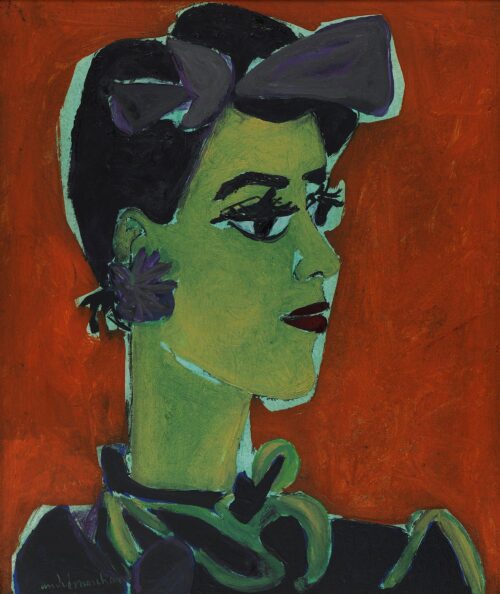
Marchand Andre (1907 - 1997)
Young Woman, 1945
His place of birth familiarized him with the landscape and the vision of Cezanne. His desire to paint led him to Paris where for a long period of time he lived in very difficult circumstances. He made friends with Tal-Coat and Francis Gruber. He remained for approximately seven months in the Biskra region in south Algeria and in 1935 took a long trip to Vienna, Warsaw and Moscow. After the war he returned for a period to his birthplace and worked in Brittany. In 1969 he visited Mexico.
He exhibited for the first time in Paris at the Salon d’Automn in 1932 and at the Salon des Independants the following year. Until the war he would exhibit very frequently with the group Forces Nouvellles, without, however, being a member. During that period he began to paint canvases of large dimensions. In 1937 he won the Paul-Guillaume Prize which assured him economic comfort, so that he could devote himself exclusively to painting. Many retrospectives have been devoted to him in Tokyo, Osaka, London, Venice, Sao Paolo and Mexico.
He was also involved with costume design, tapestry design and the illustration of books written by contemporary writers. During the period 1933 to 1937 he created a series of drawings that depicted figures whose gaze is lost in the void. Later, accompanied by Gruber, he distanced himself from the group and lived in seclusion in the forests of his birthplace. The result were paintings of small dimensions indicative of style which would influence the artists of his generation. During the war he would write that “the image which he has of the world is translated with especial violence, both in the form of things and in his chromatic vision”. He would realize this phrase of his in still lifes from this period where the objects are depicted flat and colored with exceptional intensity and would be given the name “Japanese”. The still lifes prepared the way for the large compositions of the People of Arles and the Bathers, works which would gather together all the characteristics of the previous years. To the same period belong a series of landscapes of small dimensions depicting his birthplace, with their characteristic tumultuous green color and the intense red sky which dominates the image.
From 1948 on he went into seclusion and lived in Burgundy and Provence. In his work there appeared an elliptical form of expression full of symbols which were related to hieroglyphics. This would be followed by a series of works inspired by the Atlantic coast-line. In 1960 his trip to Mexico enriched his work with new subject matter and an expanded chromatic gamut.

Young Woman, 1945

We use cookies to make our site work properly, to personalize content and ads, to provide social media features and to analyze our traffic. We also share information about how you use our site with our social media, advertising and analytics partners. Read the Cookies Policy.
These cookies are necessary for the website to function and cannot be switched off in our systems. They are usually only set in response to actions made by you which amount to a request for services, such as setting your privacy preferences, logging in or filling in forms. You can set your browser to block or alert you about these cookies, but some parts of the site will not then work. These cookies do not store any personally identifiable information.
If you disable this cookie, we will not be able to save your preferences. This means that every time you visit this website you will need to enable or disable cookies again.
These cookies tell us about how you use the site and they help us to make it better. For example these cookies count the number of visitors to our website and see how visitors move around when they are using it. This helps us to improve the way our site works, for example, by ensuring that users find what they are looking for easily. Our website uses Google Analytics for statistics reporting.
Please enable Strictly Necessary Cookies first so that we can save your preferences!